Assam Bihu
Jump to navigation
Jump to search
Bihu is a set of three important Assamese festivals in the Indian state of Assam[4]—Rongali or Bohag Bihu observed in April, Kongali or Kati Bihu observed in October, and Bhogali or Magh Bihu observed in January.[5] The Rongali Bihu is the most important of the three, celebrating spring festival. The Bhogali Bihu
or the Magh Bihu is a harvest festival, with community feasts. The
Kongali Bihu or the Kati Bihu is the sombre, thrifty one reflecting a
season of short supplies and is an animistic festival.[6]
The Rongali Bihu coincides the Assamese New year and as well as with other regions of East and South-East Asia which follow the Buddhist calendar.[7] The other two Bihu festivals every year are unique to Assamese people. Like some other Indian festivals, Bihu is associated with agriculture, and rice in particular. Bohag Bihu is a sowing festival, Kati Bihu is associated with crop protection and worship of plants and crops and is an animistic form of the festival, while Bhogali Bihu is a harvest festival.[8][9] Assamese celebrate the Rongali Bihu with feasts, music and dancing. Some hang brass, copper or silver pots on poles in front of their house, while children wear flower garlands then greet the new year as they pass through the rural streets.[10]
The three Bihu are Assamese festivals with reverence for Krishna, cattle (Goru Bihu),[10] elders in family, fertility and mother goddess, but the celebrations and rituals reflect influences from aborigine, southeast Asia and Sino-Tibetan cultures.[11][12][13] In contemporary times, the Bihus are celebrated by all Assamese people irrespective of religion, caste or creed.[14] It is also celebrated overseas by the Assamese diaspora community living worldwide.
The term Bihu is also used to imply Bihu dance otherwise called Bihu Naas and Bihu folk songs also called Bihu Geet.
Although
the modern form of Bihu is a synthesis of varied cultural elements from
diverse ethnic groups like Austro-asiatic, Tibeto-Burman, Aryan and
Ahoms, it has deep roots in the indigenous culture.[15]
| Bihu | |
|---|---|

Bihu of Assam
| |
| Official name | Bihu |
| Also called | Rongali Bihu (April) • Kaati Bihu (October) • Bhogali Bihu (January) |
| Observed by | Assamese people |
| Type | Regional folk |
| Ends | Varies |
| Date | In the months of Bohag, Kaati and Maagh |
| Frequency | Tri-annual |
| Part of a series on the |
| Culture of Assam |
|---|
 |
The Rongali Bihu coincides the Assamese New year and as well as with other regions of East and South-East Asia which follow the Buddhist calendar.[7] The other two Bihu festivals every year are unique to Assamese people. Like some other Indian festivals, Bihu is associated with agriculture, and rice in particular. Bohag Bihu is a sowing festival, Kati Bihu is associated with crop protection and worship of plants and crops and is an animistic form of the festival, while Bhogali Bihu is a harvest festival.[8][9] Assamese celebrate the Rongali Bihu with feasts, music and dancing. Some hang brass, copper or silver pots on poles in front of their house, while children wear flower garlands then greet the new year as they pass through the rural streets.[10]
The three Bihu are Assamese festivals with reverence for Krishna, cattle (Goru Bihu),[10] elders in family, fertility and mother goddess, but the celebrations and rituals reflect influences from aborigine, southeast Asia and Sino-Tibetan cultures.[11][12][13] In contemporary times, the Bihus are celebrated by all Assamese people irrespective of religion, caste or creed.[14] It is also celebrated overseas by the Assamese diaspora community living worldwide.
The term Bihu is also used to imply Bihu dance otherwise called Bihu Naas and Bihu folk songs also called Bihu Geet.
History
Indigenous origin
The origin of Bihu can be traced to the admix of the cultures of Austro-asiatic, Tibeto-Burman and Indo-Aryan peoples.The word Bihu has been derived from the Deori (a form of Bodo tongue which was once the original language spoken by the Chutiya people of Upper Assam) word Bisu which means "excessive joy". This form of Bihu was continue to be celebrated by the Chutias, Sonowal Kacharis, Thengal-Kacharis, Morans, Deoris and Motoks (majority). These groups were known as Sadiyal Kacharis, having lived in the kingdom of Sadiya. The other branches of Bodo-Kacharis which include Bodos, Dimasas, Rabhas, Tiwas, etc. have also been celebrating Bihu since ancient times. The Bodos call it Baisagu, while the Dimasas, Tiwa and Rabha call it Bushu, Pisu, Dumsi respectively.[16][17] It can be understood that over time the word "Bihu" came to replace "Bisu" in the Assamese language as can be seen with many other words like Sap-Hap, Siyal-Hiyal, Sari-Hari, Sewali-Hewali, Siloi-Hiloi, Sahas-Hahokh, etc.
There is an interesting folklore related to the origin of Bihu. It is said that Bordoisila(meaning north-westerly winds in Assamese) was the daughter of God Earth who married to a bridegroom of some distant land. Bordoisila visits her mother’s home once in year during spring time which indicates the beginning of Bihu and leaves after a few days which indicates the end of Bihu. Assam experience strong gale(wind) at that period which marks the beginning of Bihu and another strong gale after her departure which is devastating. The word Bordoisila is actually derived from the Bodo word Bordaisikhla which means "girl of storm"(Sikhla meaning girl and Bardai meaning storm). There is even a dance with the same name performed among Boro people during Baisagu which further proves that Bihu has origins in the Bodo-Kachari group.[18]
The first reference of Bihu can be found in the copperplate inscription of the Chutia king Lakshminarayan. The inscription was found in Ghilamara region of Lakhimpur district in the year 1935 and it was issued in the year 1401 A.D. It states that the king Lakshminarayan has donated land grants to Brahmins on the auspicious occasion of Bihu. It reads,
“Etasmay Shashana prada Lakshminarayana NripaThis means that on the pious occasion of Bihu, a Brahmin named Dvija Ravidev was granted land by the king. This indicates that Bihu played an important role in the social life of people of Assam at that period.
Utrijya Bisuye Punya Ravidev Dvijanme”
— Copper plate, Ghilamara(1401)
There is another popular saying among the people of Assam as,
“Dhul bai kot? RatanpurotRatanpur was known to be the cultural capital of Chutia kingdom established by the king Ratnadhwajpal which further indicates the popularity of Bihu and the Dhul among the people of that period. The wooden Khol played in Ratanpur in early times was later turned into the terracotta Mridanga(similar to the ones played in rest of the country)by the Vaishnavite saint Sankardev so that it could be used in art forms like dances and dramas.
Khul bai kot? Ratanpurot.”
— Assamese folklore
Yet another reference of Bihu can be found in the Deodhai Buranji which mentions that the capital of the Chutia kingdom, Sadiya was suddenly attacked by the Ahom forces on the first day of Bihu/Bisu in 1524(first Wednesday of Bohag/Vaisakha), when the people were busy celebrating Bihu. The Ahom general Phrasenmung Bogohain upon the advise of a Chutia general(who sided with the enemies) played the Bihu Dhul(on Ujha Bisu day i.e. 7th Bohag/Vaisakha) to trick the Chutias which ultimately led to their defeat.[19] This further proves the fact that the roots of Bihu lies in the traditions of Sadiyal Kacharis.
It is known that at an early time the Bohag Bihu celebrations started from the first week of Chaitra(Chot in Assamese) month. The period from the first week of Chaitra till the end was known as Raati Bihu or Chotor Bihu. During this period, young people danced at night in the grounds of the Than(temple). The last day of Chaitra or the first Tuesday of Bohag was when the Rati Bihu ended. This was known as the Uruka(derived from the Deori-Chutia Urukuwa meaning to end). The temple dancers Deodhani danced the entire night and were believed to be possessed by the goddess, signaling that she had descended upon earth from heaven(Bihu nomai ona). The next day was followed by Goru Bihu. The Husori was also similarly started from the temple in the past. This old tradition is still followed by the Deoris, some Sonowals, Chutias and Morans as well as the people of Sadiya. In other communities, the temple has been replaced by the Namghar.[20]
Some old Assamese Bihu folklore still hint to this tradition.
“Hasoti e chot Bisoti e chot.
Budhe Goru Bihu Mangale Uruka.
Bihu goi asili kot.”
“Boge dhari khale luitor hihu,
Mangal bare Uruka Budh bare Goru Bihu
Tar pasor dina Manisor Bihu.”
“Husori e chot asili kot.
Sadiyar ahotor tolot,
Husori e chot asili kot.
Ami je ulomu jot Dubori nogoje tot.”
“Kundilor agolit ukhokoi Himolu.It is also well-known that the modern form of Bihu dance was derived from the Faat Bihu dance celebrated in Dhakuakhana, Lakhimpur. The performers were called by the Ahom king Rudra Singha in 1694 to dance in the royal arena Rang Ghar. The origin of Faat Bihu can be traced to Sadiya. The word Faat in Deori-Chutia language means "to migrate". After the defeat of the Sadiyal Kacharis in Sadiya, the survivors were displaced from Sadiya to different places in the kingdom. A group of these people moved from Sadiya, to Dibrugarh and finally settled down in Harhi Sapori, Dhakuakhana. These people had brought the idols of god and goddess along with them and established a temple now known as Harhi Dewaloi. It was here that the first form of modern Bihu dance was developed. Later, in the 19th century, this form of Bihu dance was adopted by the other communities as well and started being performed in Mahguli sapori, Dhakuakhana by Chutias, Sonowals, Deoris, Ahoms, Mishing, etc.[21]
Tate loi kuruwai bah.
Sadiyar rajate sari haal goxani
Taloi namaskar koru.
Hunare jakhala Rupor hetamari
Ahe sari haali nami.”
The Faat Bihu dance at Harhidewaloi has been performed in the same form since the 16th century.
Tai-Shan contribution
The Tai-Shans/Tai-Ahoms(as called by the natives) upon their arrival in Assam found the natives(Tibeto-Burmans) celebrating a festival of cow-worship spraying fresh water. This ritual looked similar, to the ancestral Poin-Cham-Nyam ritual of their homeland. So, they called the existing festival of this land Poin-hu. Thus, the Bisu was later corrupted with Poin-hu to form what is today known as Bihu.[22][23]
Assamese Bihu Costume
Indo-Aryan contribution
The Indo-aryans upon their arrival in Assam helped in gradually sanskritisation of the native Bihu/Bisu to bring it to the present form. Being the pioneers of Astronomy, they further associated the term Bisu with the Visuvan day for coincidence of the Bohag bihu with other springtime festivals observed elsewhere in India on this day and adopted the festival of the natives.[25]The three Bihu Festivals
Youths perform the Bihu dance on the occasion of Rongali Bihu festival
Girls celebrating the spring Bihu (April) festival.
Bohag Bihu
Bohag Bihu (বহাগ বিহু)(mid-April, also called Rongali Bihu), the most popular Bihu celebrates the onset of the Assamese New Year (around 14–15 April) and the coming of Spring. This marks the first day of the Hindu solar calendar and is also observed in Bengal, Manipur, Mithila, Nepal, Orissa, Punjab, Kerala and Tamil Nadu though called by different names. It's a time of merriment and feasting and continues, in general, for seven days. The farmers prepare the fields for cultivation of paddy and there is a feeling of joy around. The women make pitha, larus (traditional food made of rice, coconut) various drinks by local tribes such as Chuje by Deoris/Chutias, Nam-Lao by Tai-Ahom, Aapong by Mising tribe and Jolpan which gives the real essence of the season.
Bathing and worshipping cows (Goru bihu) is a part of the Bihu celebrations.
Bihu dance marks the festival
Rongali Bihu is also a fertility festival, where the bihu dance with its sensuous movements using the hips, arms, etc., by the young women call out to celebrate their fertility.
The Seven days
Bohag Bihu or Rongali Bihu festival continues for seven days and called as Xaat Bihu. The seven days are known as Chot Bihu, Goru Bihu, Manuh Bihu, Kutum Bihu, Senehi Bihu, Mela Bihu and Chera Bihu.Kati Bihu
An Assamese woman wearing a Gamusa lighting the lantern (Saki) in a paddy field.
Bhogali Bihu
Bhogali Bihu (mid-January, also called Magh Bihu) comes from the word Bhog that is eating and enjoyment.[27] It is a harvest festival and marks the end of harvesting season. Since the granaries are full, there is a lot of feasting and eating during this period. On the eve of the day called uruka, i.e., the last day of pausa, menfolk, more particularly young men go to the field, preferably near a river, build a makeshift cottage called Bhelaghar with the hay of the harvest fields and the bonfire or Meji, . the most important thing for the night. During the night, they prepare food and there is community feasting everywhere. There is also the exchange of sweets and greetings at this time. The entire night (called Uruka) is spent around a Meji with people singing bihu songs, beating Dhol, a typical kind of drums or playing games. Boys roam about in the dark stealing firewood and vegetables for fun. The next morning they take a bath and burn the main Meji. People gather around the Meji and throw Pithas (rice cakes) and betel nuts to it while burning it at the same time. They offer their prayers to the god of Fire and mark the end of the harvesting year. Thereafter they come back home carrying pieces of half burnt firewood for being thrown among fruit trees for favorable results. All the trees in the compound are tied to bamboo strips or paddy stems. Different types of sports like Buffalo-fight, Egg-fight, Cock-fight, Nightingale-fight etc. are held throughout the day. There are other conventional festivals observed by various ethnic-cultural groups. Me-dam-me-phi, Ali-aye-ligang, Porag, Garja, Hapsa Hatarnai, Kherai are few among them. The koch celebrates this bihu as pushna.[28]Instruments used in Bihu
Bihu elsewhere
Bihu is also seen to be celebrated abroad. Many Bihu associations/committees exist elsewhere where this festival is celebrated with enthusiasm. The London Bihu Committee (LBC), UK is one of them among others.Related festivals
The Bohag Bihu (Rongali Bihu) festive day is celebrated elsewhere but called by other name.[29][30][31] Some examples of related festivals in Asia include: Indian subcontinent:- Vaisakhi in Punjab, India
- Vishu in Kerala, India
- Poila Boishakh in West Bengal, India
- Puthandu in Tamil Nadu, India
- Vaishak Ek in Nepal
- Sinhalese New Year in Sri Lanka.[32]
- Cambodian New Year in Cambodia, Thingyan in Burma, Songkran festival in Thailand and other festivals of East Asia and South-East Asia
See also
Notes
Ahom [aho]
Census Data Finder/C Series/Population by Religious Communities
- Peter Reeves (2014). The Encyclopedia of the Sri Lankan Diaspora. Didier Millet. p. 174. ISBN 978-981-4260-83-1.
References
- Barua, Hem (1973). "The Bihu Festival". Indian Literature. 16 (3/4): 35–43. JSTOR 24157200.
- Barua, Maan (2009). "The Ecological Basis of the Bihu Festival of Assam". Folklore. 120 (2): 213–223. JSTOR 40646515.
- Das, Debendra Prasad Rongali Bihu through the ages, The Assam Tribune, 14 April 2007.
- Dowerah, Sawpon Rongali Bihu-the spring festival of Assam, The Assam Tribune, 14 April 2007.
- Goswami, Prafulladatta (1988) Bohag Bihu of Assam and Bihu songs, Publication Board, Assam.
External links
Bihu dance
The Bihu dance is an indigenous folk dance from the Indian state of Assam related to the Bihu festival and an important part of Assamese culture. Performed in a group, the Bihu dancers are usually young men and women, and the dancing style is characterized by brisk steps, and rapid hand movements. The traditional costume of dancers is colorful and centred round the red colour theme, signifying joy and vigour.Contents
History
The origins of the dance form is unclear, however, the folk dance tradition had always been very significant in the cultures of Assam's many ethnic groups, such as Deoris, Sonowal Kacharis, Chutias, Moran and Borahis, among others. According to scholars, Bihu dances have their origins in ancient fertility cults. Traditionally, local farming communities performed the dance outdoors, in fields, groves, forests or on the banks of rivers.[1][2]The earliest depiction of Bihu dances come from 9th century sculptures found in the Tezpur and Darrang districts of Assam. Bihu is mentioned in the inscriptions of 14th century Chutia king Lakshminaryan as well. The first official endorsement is cited to be when Ahom king Rudra Singha invited Bihu dancers to perform at the Ranghar fields around 1694 on the occasion of Rongali Bihu.[3]
Description
The dance begins with the performers, young men and women, slowly walking into the performance space.[4] The men then start playing musical instruments, like drums (particularly the double-headed dhol), horn-pipes and flutes, while the women place their hands above their hips with the palms facing outwards, forming an inverted triangular shape.[5] The women then start to slowly move in tuner with he music by swaying, while bending slightly forward from the waist. Gradually, they open up the shoulders and place their legs slightly apart, adopting the main posture used in the Bihu dance. Meanwhile, the music played by the men picks up in temp and intensity, leading women to thrust forward their breasts and pelvis, alternatively, to the tune.[1][6]Some variations include men and women forming lines that face one other by holding each other's neck or waist, with more advanced sequences of the dance including men and women pairing up at the center of the performance area and dancing in a manner that imitates copulation.[7]
Cultural and social importance
The Bihu dance takes its name from the Bohag Bihu festival (also called Rangali Bihu), the national festival of Assam., which celebrates the Assamese New Year. The festival takes place during mid-April and the Bihu dance is meant to celebrate and emulate the seasonal spirit, celebrating fertility and passion.[8][9]Bihu is performed by groups of young men and women and in earlier times it served principally as a courtship dance. The Bihu dance's association with fertility refers to both human fertility, through the erotic nature of the dance, as well as to the fertility of nature, meaning the celebration of spring and the welcoming of the life-giving spring rain. The use of instruments such as drums and horn-pipes is believed to replicate the sound of rain and thunder, as a way of invoking actual precipitation.[1][10]
Historically, there is evidence that the Bihu dance has been looked down upon in Assamese society, especially during colonial times, because of the sexually-charged nature of the performance., which clashed with the Victorian views that were dominant at the time among British colonists.[1] Presently, the Bihu dance continues to play an important role and is a cultural emblem in the modern–day Assamese society, becoming a symbol of the Assamese cultural identity. While prior to independence, it has been chiefly a rural phenomenon, the dance has managed to make to remain relevant in the face of increasing urbanization, with the practice being adopted in the region's urban centers. The first time that the Bihu dance was performed on a stage was in 1962, part of a cultural event that took place in Guwahati.[1]
See also
External links
- A sample of a Bihu dance performance, from youtube.com.
- Other Indian Folk Dances of Various parts of India.
- Rati Bihu : A kind of bihu dance celebrated by People in Assam.
References
- Bhushan, Chandra (2005). Assam: Its Heritage and Culture. Delhi: Gyan Publishing House. p. 173. ISBN 9788178353524.
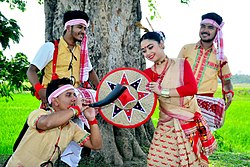
Youths perform Bihu dance in Assam
| |
| Genre | Folk |
|---|---|
| Origin | Assam, India |
| Wikimedia Commons has media related to Bihu dance. | |
| Ancient | |
| Classical | |
| Divine forms | |
| Folk (list) |
|
| Contemporary | |
| Literature | |
| By state | |
| Accessories | |
Bihu dance
The Bihu dance is an indigenous folk dance from the Indian state of Assam related to the Bihu festival and an important part of Assamese culture. Performed in a group, the Bihu dancers are usually young men and women, and the dancing style is characterized by brisk steps, and rapid hand movements. The traditional costume of dancers is colorful and centred round the red colour theme, signifying joy and vigour.Contents
History
The origins of the dance form is unclear, however, the folk dance tradition had always been very significant in the cultures of Assam's many ethnic groups, such as Deoris, Sonowal Kacharis, Chutias, Moran and Borahis, among others. According to scholars, Bihu dances have their origins in ancient fertility cults. Traditionally, local farming communities performed the dance outdoors, in fields, groves, forests or on the banks of rivers.[1][2]The earliest depiction of Bihu dances come from 9th century sculptures found in the Tezpur and Darrang districts of Assam. Bihu is mentioned in the inscriptions of 14th century Chutia king Lakshminaryan as well. The first official endorsement is cited to be when Ahom king Rudra Singha invited Bihu dancers to perform at the Ranghar fields around 1694 on the occasion of Rongali Bihu.[3]
Description
The dance begins with the performers, young men and women, slowly walking into the performance space.[4] The men then start playing musical instruments, like drums (particularly the double-headed dhol), horn-pipes and flutes, while the women place their hands above their hips with the palms facing outwards, forming an inverted triangular shape.[5] The women then start to slowly move in tuner with he music by swaying, while bending slightly forward from the waist. Gradually, they open up the shoulders and place their legs slightly apart, adopting the main posture used in the Bihu dance. Meanwhile, the music played by the men picks up in temp and intensity, leading women to thrust forward their breasts and pelvis, alternatively, to the tune.[1][6]Some variations include men and women forming lines that face one other by holding each other's neck or waist, with more advanced sequences of the dance including men and women pairing up at the center of the performance area and dancing in a manner that imitates copulation.[7]
Cultural and social importance
The Bihu dance takes its name from the Bohag Bihu festival (also called Rangali Bihu), the national festival of Assam., which celebrates the Assamese New Year. The festival takes place during mid-April and the Bihu dance is meant to celebrate and emulate the seasonal spirit, celebrating fertility and passion.[8][9]Bihu is performed by groups of young men and women and in earlier times it served principally as a courtship dance. The Bihu dance's association with fertility refers to both human fertility, through the erotic nature of the dance, as well as to the fertility of nature, meaning the celebration of spring and the welcoming of the life-giving spring rain. The use of instruments such as drums and horn-pipes is believed to replicate the sound of rain and thunder, as a way of invoking actual precipitation.[1][10]
Historically, there is evidence that the Bihu dance has been looked down upon in Assamese society, especially during colonial times, because of the sexually-charged nature of the performance., which clashed with the Victorian views that were dominant at the time among British colonists.[1] Presently, the Bihu dance continues to play an important role and is a cultural emblem in the modern–day Assamese society, becoming a symbol of the Assamese cultural identity. While prior to independence, it has been chiefly a rural phenomenon, the dance has managed to make to remain relevant in the face of increasing urbanization, with the practice being adopted in the region's urban centers. The first time that the Bihu dance was performed on a stage was in 1962, part of a cultural event that took place in Guwahati.[1]
See also
External links
- A sample of a Bihu dance performance, from youtube.com.
- Other Indian Folk Dances of Various parts of India.
- Rati Bihu : A kind of bihu dance celebrated by People in Assam.
References
- Bhushan, Chandra (2005). Assam: Its Heritage and Culture. Delhi: Gyan Publishing House. p. 173. ISBN 9788178353524.

Youths perform Bihu dance in Assam
| |
| Genre | Folk |
|---|---|
| Origin | Assam, India |
| Wikimedia Commons has media related to Bihu dance. | |
| Ancient | |
| Classical | |
| Divine forms | |
| Folk (list) |
|
| Contemporary | |
| Literature | |
| By state | |
| Accessories | |
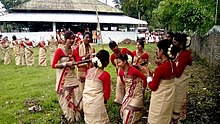

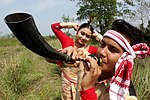

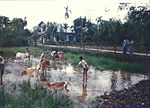






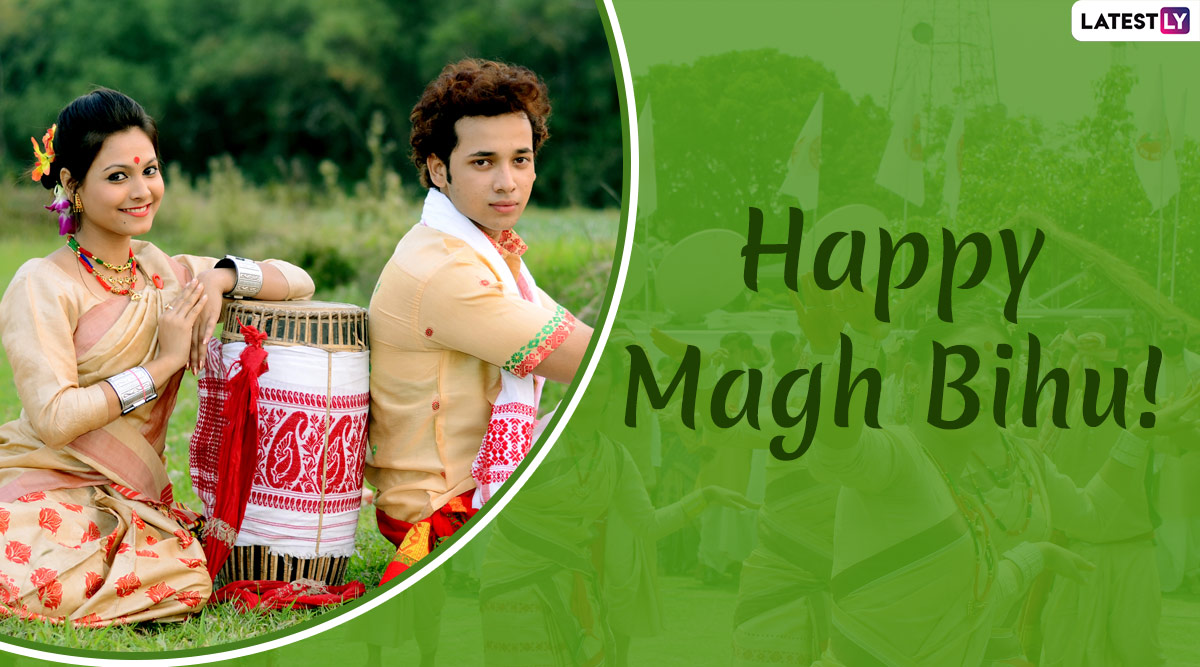
No comments:
Post a Comment